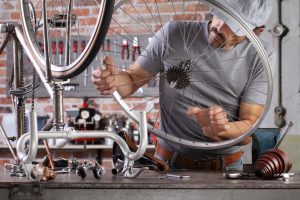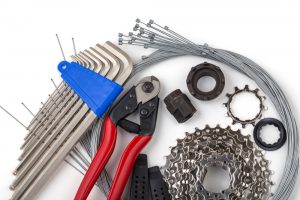Electric bikes are rapidly increasing in popularity and the main reason that sparked the flame could be the recent Covid-19 pandemic situation. It has proven to be a great way to avoid public transport and still get to your destination in good time. Apart from that, their gradual rise to fame could also be owed to the fact that they advocate for clean energy. Many people have started realizing the damage they have been doing to the environment over the years and are starting to feel the repercussions of it. This has made them feel the need to become more responsible and to set an example for the future generation to come. E-bikes might not be a game-changing choice, but it does make an impact on the world’s carbon footprint if mass numbers of people shift from the usage of fossil burners to electric vehicles such as e-bikes.

The thing about e-bikes in the current time is that they have not yet been perfected. The global market for e-bikes is still expanding with no competitor having a significantly large share for themselves. This means that e-bikes are still undergoing research and innovation and it might take some time to come up with the perfect bike. So there can be many inefficiencies and inconveniences that one has to face while using them. And the existing e-bikes might not be exactly what you are looking for. This brings us to the topic of building your own e-bike!
Why Build Your Own E-Bike?

There are several reasons why one might attempt to build their own e-bike.
- Cheaper
- The cost of an e-bike you get from the store covers a lot of extra costs that go for research, design, development, marketing, storage, shipping, and more. When making your own e-bike you will be cutting off a large chunk of these expenses. Moreover, you can avoid including the extra components that come with store-bought e-bikes which you won’t be using thereby, cutting those costs as well.
- Customization
- When building your own e-bike, you get to customize it the way you want. This includes getting rid of parts that you don’t need or dislike, and adding parts that would make your riding experience better. For instance, not all e-bikes are suited for mountain biking or riding through tough trails. And such bikes might not be available at your local e-bike store. So in a situation like that, you can make a custom e-bike which you can even modify whenever you like. It is more like personalizing a bike for yourself and who better knows what you’re more comfortable with than yourself!
- Easy assembly
- Putting together an e-bike is now easier than ever before. You can find bicycle conversion kits that are specifically made for you to make your own e-bike. And there are so many DIY tutorials on the internet. So you don’t have to be a super mechanic who knows all the inner workings of an e-bike to make one yourself!
- Quality assurance
- There are various e-bikes brands on the market but not all of them are foolproof and of high quality. Moreover, it’s hard to be picky when there aren’t many good options to choose from in the first place. By building an e-bike yourself you can make sure that the parts you use are of high quality and secure.
- Fun
- The process of making an e-bike can be fun and seeing the end result will give you a sense of accomplishment. Imagine yourself sailing through the streets on an e-bike you made yourself. That would be the coolest experience and will give you a moment to shine in pride. If you go on YouTube, you’ll see a lot of Youtubers who’ve attempted making e-bikes where some of them were successful and some just ended up being hilarious.
Risks Of Homemade Electric Bikes

While making your own e-bike can be a great experience, it can be very hazardous if you go about it without knowing what you’re doing and not heeding the safety precautions given to you. For instance, your e-bike may go at a really high speed that you may not have expected. This risk is especially apparent in throttle-assisted bikes and hence your first ride might be a very scary one. And in the recent past, many people who built their own e-bikes purposely gave their bikes extreme speeds with hefty motors. This was done for ‘fun’ and clout, and often resulted in accidents. So make sure to follow the instructions properly, and wear safety gear when going on your test drives.
Nonetheless, such risks are the main reason why some countries have made registration, license, or insurance a requirement for some e-bikes.
Does My Homemade E-Bike Need To Be Registered?

To officially run your homemade e-bike on the road you might need to get it registered first. But this depends on the country or state you live in. Some countries do not require registration as e-bikes do not fall under the motorcycle category and transport rules such as insurance or taxes are not applicable. In addition to that, whether or not your e-bike needs to be registered would also depend on the type of electric bike you’ve made and the motor used. For instance, in India, you do not require an ARAI approval for an electric bike as long as its electric motor has a power of less than 250W and can be ridden at a maximum speed of 25kmph.
In Which Scenario Will My E-Bike Need Registration?

Since there are no construction laws in any country for a homemade electric bike, you will only need to comply with the usage law, i.e., a 250W motor and 25kmph maximum speed as mentioned before. As long as your e-bike complies with the law, you can ride it on roads or bike paths in most countries.
However, if these requirements are not met, your e-bike will be treated legally as a motorcycle. If it falls under the motorcycle category, you will be required by law to wear a helmet when riding and get insurance for your e-bike. Nonetheless, if you do have a high-powered e-bike and no registration, you can still ride it on private land.
In addition to that, in many countries, there is an age limit to ride an e-bike on public roads. This can vary from 14-18 depending on the place you live. For example, in the UK, the minimum age limit to ride an e-bike is 14. Furthermore, if you are using your e-bike on a public highway, you will most definitely need to register the e-bike as well as get a driving license, insurance, and wear a helmet when riding.
There is an additional issue when registering a homemade e-bike though as most countries do not allow it unless the bike complies with certain standards. When buying off-the-shelf bikes, most of them come with a type of approval certificate that conforms with the European standards for e-bike manufacturing. In addition to that, they might have a sticker or plate showing the manufacturer’s name and the power output details to confirm there is no power assistance without pedaling. Due to this, when it comes to a homemade e-bike, it makes registration a bit more difficult. Without a legal certificate, it is difficult to confirm that your bike meets the construction and usage regulations for e-bikes. Nevertheless, in countries like the USA, there is a possibility to get your e-bike inspected before registration. The inspector will look into details such as how the motor was mounted if all the safety features are functional like head and tail lights, mirrors, and horns. Having insurance will be an added bonus for you when it’s time to register.
Registration Laws For E-Bikes By Country

Different countries have different registration laws for e-bikes. So in order to figure out whether your homemade e-bike needs to be registered, and if it is compatible with registration, you must take a look at the laws specified by your country.
USA and Canada

Every country has different rules and registrations for e-bikes. In large countries such as the USA it depends on the states like Virginia, the e-bicycles don’t need to be registered and are not categorized as motorcycles. In other states such as California, there are many classes to consider when registering your e-bike. Registration is only required for e-bikes traveling above 28mph. Also in California, riders have to be above 16 years old to go over 20mph. In places like Wisconsin, they do not have comprehensive e-bike laws, however, you still need to abide by regulations such as a 750W motor, riding less than 20mph, and not riding on “bike paths” while under motor power.
You should beware of the state you live in as in places like Michigan, all motorized vehicles should be registered. If your bicycle has a fitted motor it is classified as a moped, or motorcycle therefore registration is necessary. Although insurance might not be necessary, the motor vehicle rules will apply to your e-bike. In that case, you are required to have a license, satisfy all the safety gear, lights, seat, and handlebar requirements limitation of riders and not exceed a speed of over 30mph. You will have to register your e-bike under moped with an identifying frame serial number.
In Canada, the law for electric bicycles depends on the province you live in. There are eight provinces that allow you to ride them on roads. However, even in these provinces, you will need to abide by the rules that your self-made e-bike has an output of less than 500 W, and there is a speed limit of 32 km/h when traveling on motor power alone on level ground. Nevertheless, in some parts of Canada, the output power and speed limit may differ.
Australia and New Zealand

In countries like Australia, highway registration is not required as any motor vehicle is not allowed on a highway. There is an exemption for trailers, however, it does not extend to motorized/electric bicycles. As an electric bicycle has a motor it is not classed as a bicycle and considered a motor vehicle. Like in the UK and India, for an e-bike to be considered a motor vehicle: the motor should be the primary source of and the capacity of the ungoverned power output exceeding 200 watts. The rules do vary depending on the state, but e-bike riders are required to hold a motorcycle license and have the vehicle registered if they want to ride it on the road network. Furthermore, as a “motor vehicle” e-bikes cannot be ridden on footpaths or bicycle paths and must always wear a motorcycle helmet.
In New Zealand, the law classifies e-bikes as ordinary cycles as long as the bike has an electric power of less than 300 W, rather than motorcycle vehicles. Therefore, if you live in New Zealand the e-bike you made meets these regulations, it is not necessary to register or license them.
Europe

As mentioned previously in the UK the registration is similar to India however, the weight of the bike is limited to 30 kg. In Belgium, the rules depend on the motor of the e-bike you have made. There are 3 classes for e-bike types which are: 250W that can be ridden at 25 km/h by all ages without a helmet, 1000W bikes that require a conformity certificate, and the rider to be above 16 years that can also be ridden without a helmet and lastly,4000 W which you can ride up to a speed of 45 km/h but fall under the category of mopeds for all requirements. Denmark follows the same rules and allows you to ride it on cycle paths as long as you are above 15 and wear a helmet. The rules are laxer in parts of Europe like Norway and Sweden where e-bikes are classified as ordinary bicycles, in accordance with the vehicle regulation. So, registration and licenses are not needed to ride electric bikes there. They do have rules on e-bike construction so beware that your homemade bike abides by construction and safety laws in those countries even if registration isn’t required.
Asia

In most Asian countries e-bikes fall under the same classification as bicycles such as the Philippines, therefore, even if your electric bike is homemade, it shouldn’t be a problem, and no registration is required. However, due to accidents and safety concerns, e-bikes are banned in some places in Asia or considered as motorcycles like in Hong Kong, therefore you might need to register and get approval from the Transport Department.
In Japan, electric bicycles are only categorized as ordinary bicycles if they are not capable of propulsion by just electric power. If your e-bike and run on just electric power it falls into the moped category therefore may require additional regulatory requirements and registration. In case you need to register your homemade e-bike in Japan, you will need to make sure the power assist mechanism operates safely and the electric power generation by a motor ticks off all the requirements.
In middle eastern countries like Israel, the age limit is above 16 years old to use an electric bicycle with a speed limit of 25 km/h and a motor power of 250 W. All bicycles in Israel should meet the European Standard EN15194 and be approved by the Standards Institution of Israel. Therefore, if it is a homemade bike you will need to discuss and get your bike inspected by the Standards Institution. A new law was passed recently that states you need a special permit to ride an e-bike if you are under the age limit, therefore you will need to register for the permit depending on your age. You are not required to have a license or insurance. However, for you to ride on the streets the safety regulations you should follow are: the weight of your e-bike cannot exceed 30kg, the motor should be only activated by the pedaling effort and shut down when the rider stops pedaling and the motor power should decrease and cut off completely whenever the bicycle reaches a speed of 25 km/h. Russia is another country where no registration is needed for your e-bike. However, the same rules as in India apply for the motor power and speed limit.
Conclusion

Building your own e-bike can be cheaper and a fun experience. But if you are looking forward to riding it on the streets you will have to get a good idea about the e-bike laws in your region. Moreover, according to the definition of e-bikes stated by law, your product might not even classify as one. Which means a different set of rules may apply for them.
Due to this, getting your homemade e-bike registered can be a complicated process. If you can first go through the registration requirements before building your e-bike, and then build it accordingly, it will make the process much simpler.
